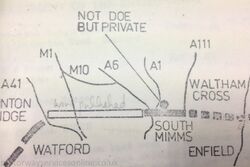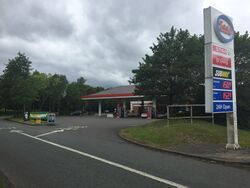Private Initiative

Private initiative ("PI", sometimes called private enterprise) was a phrase used in the 1980s to describe a series of experiments which would ultimately change how motorway service areas are built.
The idea came about as a result of the Prior Report of 1978, which focused on how the industry had been stunted by the government's interference. The original policy was that the government would identify the site of a new service area, and then invite different developers to compete over who could submit the best bid to run it.
By the mid-1970s, the government were struggling to get new sites through the planning process and, when they did, operators were showing no interest. After Rothersthorpe had opened in 1978, the government's traditional tender system produced no successes until 1992.
Fortunately, during that dry spell, the publication of the Prior Report meant that the Department of Transport were open to new ideas. The term "private initiative" was first used by them in October 1979, where they said they were open to a 'sale and leaseback' scenario where a landowner would sell them the land in exchange for the immediate right to run a service area on it. The DoT said this would be used in cases where "the competitive tendering method is inappropriate", though it's not clear what this had in mind.
The finished service area would still operate in line with the regulations at the time, but it meant that the Department of Transport would have no issues acquiring the land, and wouldn't need to spend so much time finding suitable locations. Generally, private initiatives required the developer to pay for the roadworks, which meant they were expensive to build - but they were also more profitable because the developer could choose the precise location.
As if the subject wasn't confusing enough, in 1992 the government talked about single tenders. This is where the contract to run a service area was given to the company who sold the land. By the government's own definition, surely this was an example of "private initiative".
Examples of Private Initiatives
The following service areas were described as "private initiatives" in the government's paperwork:
- Ferrybridge: opened in 1985; proposed by a landowner, tendering wasn't attempted because it had already failed at Hensall
- Sedgemoor: opened in 1986/87; the government already owned the land, but the operators ran buildings here
- South Mimms: opened in 1987; proposed by the government, where they purchased a service area which had already been built
- West Kingsdown: not built, and not clear how it would have worked
- Tebay southbound opened in 1993; the land was already owned by Westmorland
- Warwick: opened in 1994; the land had been purchased by Mobil
- Maidstone: opened in 1997; the land had been purchased by Esso
As can be seen, these private initiatives meant that some service areas did open during the 'dry spell' mentioned above, but still not that many. The last three were examples of single tenders. Other examples of single tenders, which weren't private initiatives, were:
- Washington: opened in 1970; awarded to the company who owned the land, but long before the idea of private initiatives had been thought up
- Strensham northbound: opened in 1991; but strictly speaking it had only moved to a new location
- Knutsford and Birch were never moved as previously planned, but if they had been they would have counted
Area Search

Another 1980s experiment was the idea that the Department of Transport would specify a section of road, and invite the developers to find a suitable place for a new service area. If it ticked all the right boxes (including "being easy to purchase"), the Department of Transport would acquire the land and award the contract to the developer who found it.
The only known example of a motorway service area built this way was Tamworth, but if policies hadn't changed, the Department would have used it on the M25 and M40.
This was another interpretation of "private initiative".
Legacy
The concept of private initiatives became a victim of its own success.
Towards the end of the 1980s, the Department of Transport found that when they proposed a new motorway service area, companies such as Mobil would propose one next door. This put the Department in an awkward position: they either had to spend money arguing that their proposal was better, or throw away the money they had already spent and let Mobil have it.
This was one of the reasons why, in 1992, the Department of Transport opted to cease all involvement in motorway service area development. From now on all new motorway service areas (ignoring ones which had already been signed off) would be a private initiative, so there was no need for the phrase any more. At the Thurrock opening ceremony in September 1992, the government claimed this was the start of the new era, but Thurrock had actually been built and opened under the previous system. The first of the new era was most likely Durham in 1994.
The traditional tendering process produced a few more successes in the early 1990s before the private sector took over completely.